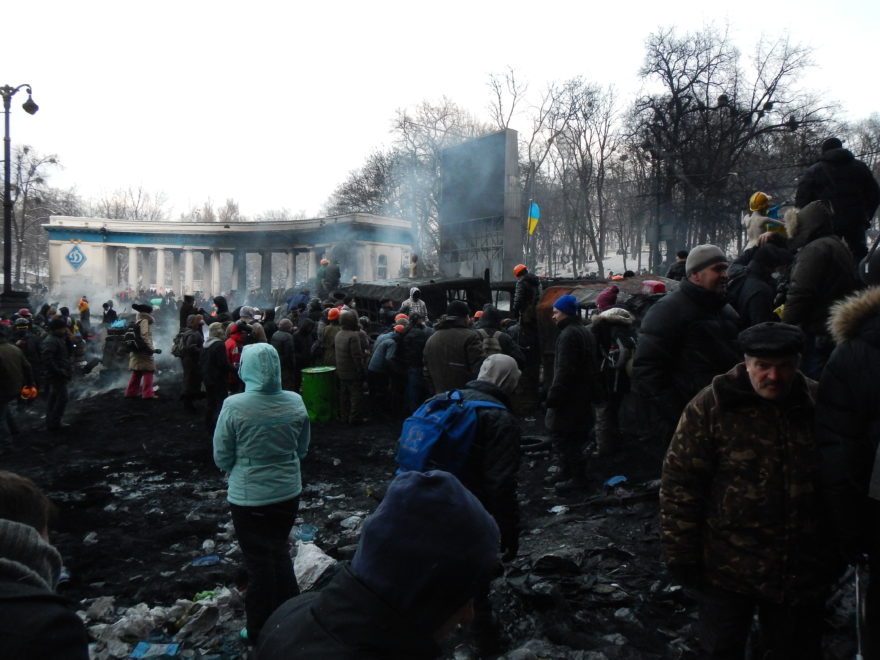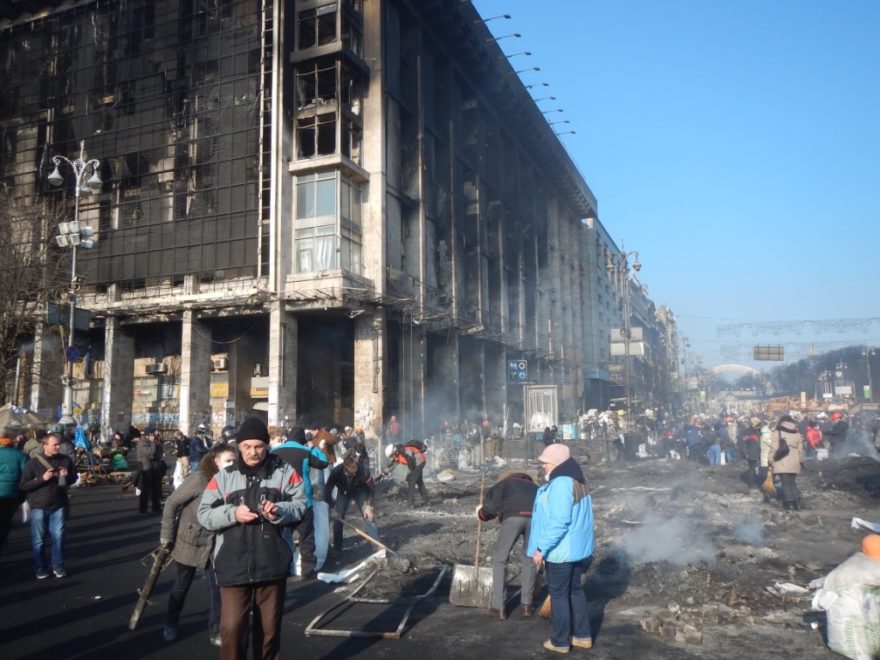– The demonstrations were initially triggered by the association agreement, but quickly evolved into being about something entirely different, says Arve Hansen.
Since gaining independence in 1991, Ukraine has struggled with an unstable economy, high levels of crime, and corruption. Hansen explains that the association agreement with the EU was seen as the solution to these issues for many.
– Not only would this lead to new economic opportunities, but also open for World Bank loans and EU support to reform the political system.
On November 21, 2013, then-President Viktor Yanukovych declared that he would not sign the agreement with the EU.
– The refusal to sign the agreement angered many Ukrainians. A large crowd gathered at Maidan, in the center og Kyiv. They declared that they would not leave until the agreement was signed, Hansen says and elaborates that despite the significant number of people, it was not an extremely large movement.
It was only after eight days, when the protest camp was attacked by riot police, that the momentum of the resistance movement started to build. Hansen clarifies that as the demonstrations endured increasingly brutal violence, a greater number of people gathered to protest against the regime.
However, the regime chose to remain silent instead of negotiating with the opposition for a solution.
– The chaos and violence in the capital escalated, provoking anger in many.
Symbol of everything wrong
As the violence increased, the president became a symbol of everything wrong in the country. Hansen explains that Yanukovych had a previous criminal record and leveraged his connections in the criminal world to become governor, prime minister, and president.
– He gathered enormous wealth during his tenure as an elected politician. We’re talking about chandeliers worth hundreds of thousands of dollars, a collection of luxury cars, and a private zoo.
Yanukovych used the state apparatus to suppress the opposition and protect his wealth.
– The entire resistance movement at Maidan agreed that he had to step down.

Spiral of violence
– Initially, people were happy, engaging in humour and song, creating an optimistic ambiance in the city.
But then everything changed.
With all the violence, people became angrier. In January 2014, the parliament passed a set of laws that practically established a dictatorship as the official form of government.
– The emotional climate changed from frustration to intense rage. It was in the days and weeks that followed that i truly witnessed a spiral of violence unfolding in Ukraine.
The emotional climate changed from frustration to intense rage.
Maidan fell silent
– There were many things that left an impression on me. I particularly recall a time when I went to Maidan, and a news broadcast was shown on a large screen for the demonstrators.
The segment featured a video clip of a group of soldiers from the Ministry of Internal Affairs pulling a naked and battered protester out of a prisoner transport. This occurred in January.
– It was freezing outside. The soldiers posed for photographs with him, subjecting him to several minor blows, before ultimately kicking him back into the bus.
Hansen mentions that there were several hundred, perhaps up to a thousand people at Maidan that day.
– For a moment, it became completely silent. It was as if everyone was trembled with rage.
One person started shouting ‘Shame! Shame! Shame!’ and the whole square joined in shouting this. Hansen says it’s not surprising that people threw stones at the police after such an incident.
– And there were so many similar incidents, he adds.
Protected art
Hansen was trying to remain neutral to what was happening. He observed, took pictures, and conducted the occasional interview. He was there to witness and understand. Only once did Hansen actively participate in what was going on.
This was in late February 2014. Over a hundred protesters at Maidan had been killed, and Hansen had met a Ukrainian local historian. Hansen was supposed to interview him, but then the local historian received a call from some activists.
– The activists needed help evacuating paintings and other artworks stored in Ukraine House, just a few hundred meters from the clashes, Hansen says. He adds that the day before, the Trade Union House at Maidan had burned down.
– If Ukraine House were to catch fire as well, Ukraine would risk losing priceless art.
Hansen thought this was a worthy cause and therefore, assisted in transporting massive paintings, antique furniture, and other items to Kyiv’s history museum.
– It was overly exciting. Not only because I was carrying Ukraine’s national heritage, but also to see how the evacuation was organized and executed so organically and swiftly, without any form of central leadership or coordination

United Ukraine
While the revolution was ongoing, many Western media outlets framed it as an East-West conflict, portraying it as an ideological struggle between pro-European Ukrainians in the west and pro-Russian Ukrainians in the east.
– This is not accurate. Maidan became the epicenter of a resistance movement from across the entire country.
People had diverse ethnicities and religions, spoke different languages, and represented a multitude of ideological and political orientations.
– They were united against a common enemy threatening the entire democratic system, Hansen says.
Ha further states that several of his Ukrainian friends had no interest in politics before 2013. They were often uncertain about whom to vote for and would ask their parents how to cast their vote on the day of the election.
– This changed after the revolution. I always receive long, informed answers if I ask the same question now. It indicates a political awakening among Ukrainians.
The brutality could have been avoided
Hansen witnessed numerous clashes with security forces. He recounts one of the most extreme confrontations he observed during the battles on Hrushevsky Street on January 19, 2014.
– I saw protesters being shot with shock grenades, and a Molotov cocktail exploded among a group of police officers. This speaks to how radicalized both sides of the barricades had become, he says.
Hansen adds that he believed then, and still believes, that much of the brutality could have been avoided if Yanukovych had behaved differently.
From the Dignity Revolution to War
– One should be cautious about saying that the Dignity Revolution led to the war with Russia, as this undermines the importance of everything the protesters stood, fought, and died for.
He views the revolution as an attempt to rid themselves of an old and highly dysfunctional political system.
– Someone I spoke to referred to it as the ‘ghosts of the Soviet Union.’ The revolution was, on one hand, a resistance movement against corruption and abuse of power, and on the other hand, a desire to create a new and better society based on ideas of democracy and human rights.
Since the Dignity Revolution, Ukrainians have had to fight against dictatorial forces for over ten years to maintain what they gained in 2014. Ukraine has been invaded by Russia several times, and they have truly understood what it means to fight against the Russians’ brutal war machine, Hansen says.
– Every day, new war crimes are documented, and in every small village, town, or city the Russians have passed through, you find mass graves and torture chambers.
The Dignity Revolution created an idea of what Ukraine is and an understanding of what Ukraine can achieve if the people stand together, he adds.
– The war that followed has solidified and strengthened this idea. Together, they have managed to stand up against one of the world’s largest and most brutal military powers for over ten years.
